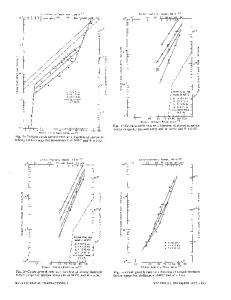Fatigue crack growth of SM-1240/TIMETAL-21S metal matrix composites at elevated temperatures
- PDF / 2,774,854 Bytes
- 10 Pages / 598 x 778 pts Page_size
- 87 Downloads / 373 Views
I.
INTRODUCTION
THE development of continuous-fiber-reinforced titanium composites is particularly critical for use in high-temperature structural components which are stressed in one dimension only. A key issue in the potential success of these materials is the understanding of their high-temperature damage tolerance characteristics with respect to timedependent-related effects, including inelastic deformation and environmental attack. Few studies have, however, been made in the area of high-temperature damage and, in particular, the high-temperature fatigue crack growth behavior of continuous-fiber-reinforced metal matrix composites. The current literature shows that the optimum combination of matrix toughness and interfacial strength is achieved when the crack bridging becomes the principal damage mechanism in the metal matrix composites, tin,31 The crack bridging was found to occur in titanium matrix composites under conditions of practical interest, and work at ambient temperature showed that bridged fibers can provide shielding effects which decrease the crack-tip driving force, thus enhancing the composite resistance to crack propagation.t2 5j In the crack bridging mechanism, the crack growth rate is governed by a process in which the increase in the crack length is accompanied by an increase in the number of fibers bridging the crack. This would continue up to a "steady state" condition produced by the competition between creating more bridged fibers as the crack length increases and the fracture of these fibers as more stress is transferred to them by the increased crack-opening disD. ZHENG, Research Associate, and H. GHONEM, Professor, are with the Mechanics of Materials Laboratory, Department of Mechanical Engineering, University of Rhode Island, Kingston, RI 02881. Manuscript submitted May 17, 1993. METALLURGICALAND MATERIALSTRANSACTIONSA
placements. Here, however, it appears to be difficult to define the conditions at which stable/unstable crack growth transition occurs. [21Although the subject of the crack bridging is very important and is attracting increased attention, a full understanding of related phenomena in metal matrix composites, such as defining a failure criterion for bridged fibers, remains an open issue.m This situation is further complicated in cases involving elevated temperatures where fewer studies have been attempted. Bain and Gambone worked on SCS-6/Ti-6AI-4V at 318 ~ for frequencies of 20, 0.33, and 0.033 Hz. [61 Their results showed that while there was no considerable difference in the fatigue crack growth rates for the first two frequencies, the fatigue crack growth rate for the 0.033 Hz testing increased by a factor of 40. This increase was attributed to environmental damage affecting the Ti-6A1-4V matrix material. They, however, did not observe changes in the fracture surface features of specimens tested at the three different frequencies. No crack bridging was reported in their work, and for all their tests, the fatigue crack growth rate increased in proportion to the inc
Data Loading...











